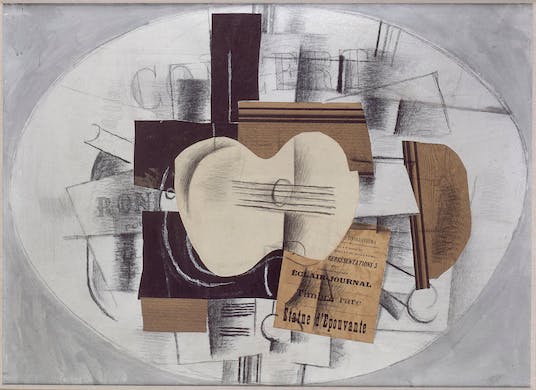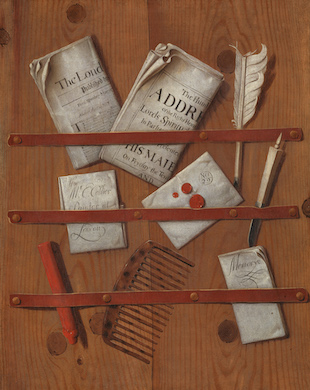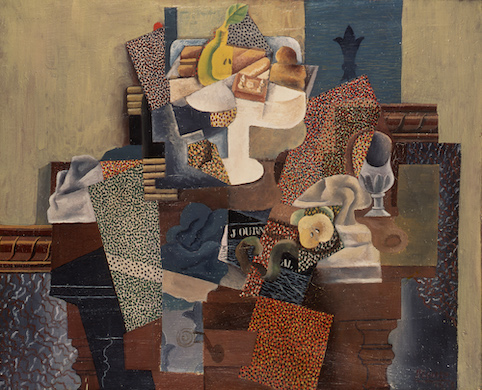At the Met, What You See, and What You Get
‘Cubism and the Trompe l’Oeil Tradition’ achieves what one hopes of any exhibition; it prompts us to reconsider what we thought we knew.

‘Cubism and the Trompe l’Oeil Tradition’
Metropolitan Museum of Art, Through January 22
What is real, and when? It all depends, apparently. The title of this exhibition appears at its entrance in large, stately capital letters that look to have been painted with lighted and shadowed portions, as if chiseled into the wall. Yet touch the letters and you’ll see this isn’t an effect: They’re indeed “real,” painstakingly carved into the surface.
In the show’s first gallery, a corner of the wallpaper looks to have detached and begun curling away from the wall. Move up close, and this too turns out to be an illusion: The curl is just painted on.
Seven years in the making, with loans from more than a dozen museums, the Met’s “Cubism and the Trompe l’Oeil Tradition” is a highly engaging exhibition of more than a hundred works exploring the contradictory relationship between the real and the depicted. The wall texts seem to float, thanks to fake cast shadows, and they also advance a novel argument: Namely, that trompe l’oeil painting, a popular genre bridging 17th-century Holland and 19th-century America, had a sizable impact on 20th-century Cubism. On display are scores of works ranging from baroque-era still life paintings to 1890s wallpaper samples and Modernist collages, often intermixed to drive home the point.
Is art historian Kenneth Clark spinning like a lathe in his grave? Traditional academics viewed trompe l’oeil painting — which promoted an art so minutely illusionistic that it could ‘’fool the eye” — as a relatively minor, even provincial, development. Cubism, on the other hand, has been widely considered one of the most significant movements of the Modernist era. Such debates, however, may not concern museum-goers, who can be sure of one thing: They will be treated to more than 60 striking works by the three major Cubists: Pablo Picasso, Georges Braque, and Juan Gris.
Certain motifs served the trompe l’oeil artists especially well. They favored the likes of close-up views of letter racks (boards criss-crossed with thin straps for holding written correspondence), and studio walls hung with musical instruments and bits of crinkled paper. To these naturally low-relief subjects, the artists applied standard modeling techniques, such as shaded volumes, cast shadows, and overlapping elements. When executed with a deft touch, the subjects could appear startlingly real. Several 17th-century letter-rack paintings in the exhibition, produced by Dutch, Flemish, and Spanish artists, attest to the enduring popularity of the genre.

The wall text describes how academic critics “despised” trompe l’oeil as a mere showcase for technical virtuosity. They did have a point: Trompe l’oeil painting can seem today like an early form of “eye candy” — works intended not to elevate our understanding but to hone, to the point of spectacle, certain capabilities of painting. Even so, the results can be luminous; William Michael Harnett’s “Still Life–Violin and Music” (1888) imparts a glowing, atmospheric depth to the ensemble of a horseshoe, a violin, and a piccolo, all hanging in front of a rough-hewn wooden wall.
Connecting many of the trompe l’oeil artists is a witty self-awareness about their practice. They depicted other paintings inside their paintings, and frames within their painting’s actual frames; they added their signatures and references to collectors on seemingly appended pieces of paper.
This playful examining of the act of representation re-emerges in the work of the Cubists, along with the frontal compositions and predilection for scraps of printed paper. The Cubists, in fact, used the very same device of a single nail projecting from a wall, in 3-D fashion, while casting a flat shadow — the ultimate one-pan recipe for illusionistic depth.
Picasso, Braque, and Gris also went much further, of course, abstracting forms and incorporating actual objects, such as fragments of wallpaper, patterned prints, and newspapers. At times they appended calling cards, silverware, pieces of mirror, and bits of rope. They simulated wood textures with both paintbrushes and decorators’ graining combs. In what might be called a faux-faux-technique, they even simulated with brushstrokes the textures of a graining comb.
Yet there is something even more rewarding about the Cubist works than these sleight-of-hand stratagems. Picasso, Braque, and Gris all happened to be superb painters, and their work, like that of the great masters, searches for — and often finds — a different reality than that of the trompe l’oeil artists.
Just what is real in painting? Reduced to its essence, every painting is pure artifice: the procedure of slicing out a rectangular view of the world, and affixing it as patches of pigment to a flat surface. The trompe l’oeil artists very capably re-created the light-revealed volumes they observed in life, and this is no small feat. But fashioning a further truth — an impression of how and why each object occupies its space — entails something more: a sense of the momentum of events, and their rhythmic necessity.
The great masters achieved this. Chardin could make the slender, rising neck of a vase practically tremble in place; Goya could lend a preternatural presence to a pile of fish; and Courbet could endow apples with boulder-like heft. In their various ways, Picasso, Braque and Gris pursued this kind of truth in their pre-Cubism years. Their Cubist works move us with the bold, new directions of their steadfast pursuits.

These different notions of truthful painting often hang side by side in the exhibition, generally to the benefit of the Cubists. Although impressively illusionistic, J.S. Bernard’s “Still Life with Violin, Ewer, and Bouquet of Flowers” (1657) is a jumble of bright colors, each element pressing equally before the eye. Next to it, Picasso’s “Still Life with Compote and Glass” (1914-15) may appear, stylistically, to be just a patchwork of multi-colored, multi-textured bits of color, but compared to the Bernard it gleams with an almost dignified sense of order. Its color-forms add up; one feels the impact of every interval between the goblet, the halved apple, and the newspaper, as they proceed across the tabletop. Lofted above, pastries tangibly nestle in the depths of the pale compotier.

Columbus Museum of Art, Gift of Ferdinand Howald.
© 2022 Estate of Pablo Picasso/Artists Rights Society (ARS), New York
Similarly, Evaristo Baschenis’s large “Musical Instruments” (circa 1665-67) depicts, with remarkable concision, a cello lying atop a lute, violin, and instrument case. Chardin could get extraordinary mileage out of subtle color shifts, but less so Baschenis, whose browns — of table, cello, and floor — tend to mix indifferently. Details that might draw us in, like the apples peering out from behind the cello’s strings, prove anticlimactic.
Juan Gris’s “Fruit-Dish on a Striped Cloth” (1914) hanging nearby may be far smaller in its dimensions, but it looms larger. Although its fragmenting forms and upended perspectival lines defy any logical notion of the real, the painting attains its own lyrical truth. We feel a startlingly strong impression of looking down, from a distance of perhaps 30 inches, at a bright plate and tablecloth, made buoyant by surrounding areas of woodgrain wallpaper and dark green paint. Entities emerge, mysteriously, from a flux of discontinuities. A goblet springs away from the plate (resisting not gravity but its very roundness) while folded biscuits or pastries pace out its expanse.
A number of works on paper by Picasso and Braque feature overlapping bits of wallpaper and newspaper at their centers, with wide margins of blank paper shaped by a few crucial lines and tones. In Braque’s “Still Life: Playing Card, Bottle, Newspaper, and Tobacco Packet (Le Courrier)” (1914), a fan-shaped array of wallpaper and newsprint strips expands robustly across the center, to be contained — barely — by a plate’s crisp edges, drawn lightly in charcoal.

The Metropolitan Museum of Art, Leonard A. Lauder Cubist Collection
“Cubism and the Trompe l’Oeil Tradition” achieves what one hopes of any exhibition; it prompts us to reconsider what we thought we knew. For me, this had less to do with the influence of trompe l’oeil painting than with the individual achievements of the Cubists. Picasso has rarely appeared humbler in his searchings than in this show, and seldom so free of his usual swagger. Braque melds craft and insight with particular vigor. As for Gris — well, his paintings are the highlight. Where else can one find images at once so surgical and dream-like, so strange, wild, and penetrating?
In 1919, with his usual precision, Gris described his intentions to his dealer, Daniel-Henry Kahnweiler: “I would like to continue the tradition of painting with plastic means while bringing to it a new aesthetic based on the intellect,” he wrote. “I think one can quite well take over Chardin’s means without taking over either the appearance of his pictures or his conception of reality.”
Well put, and nicely done.

